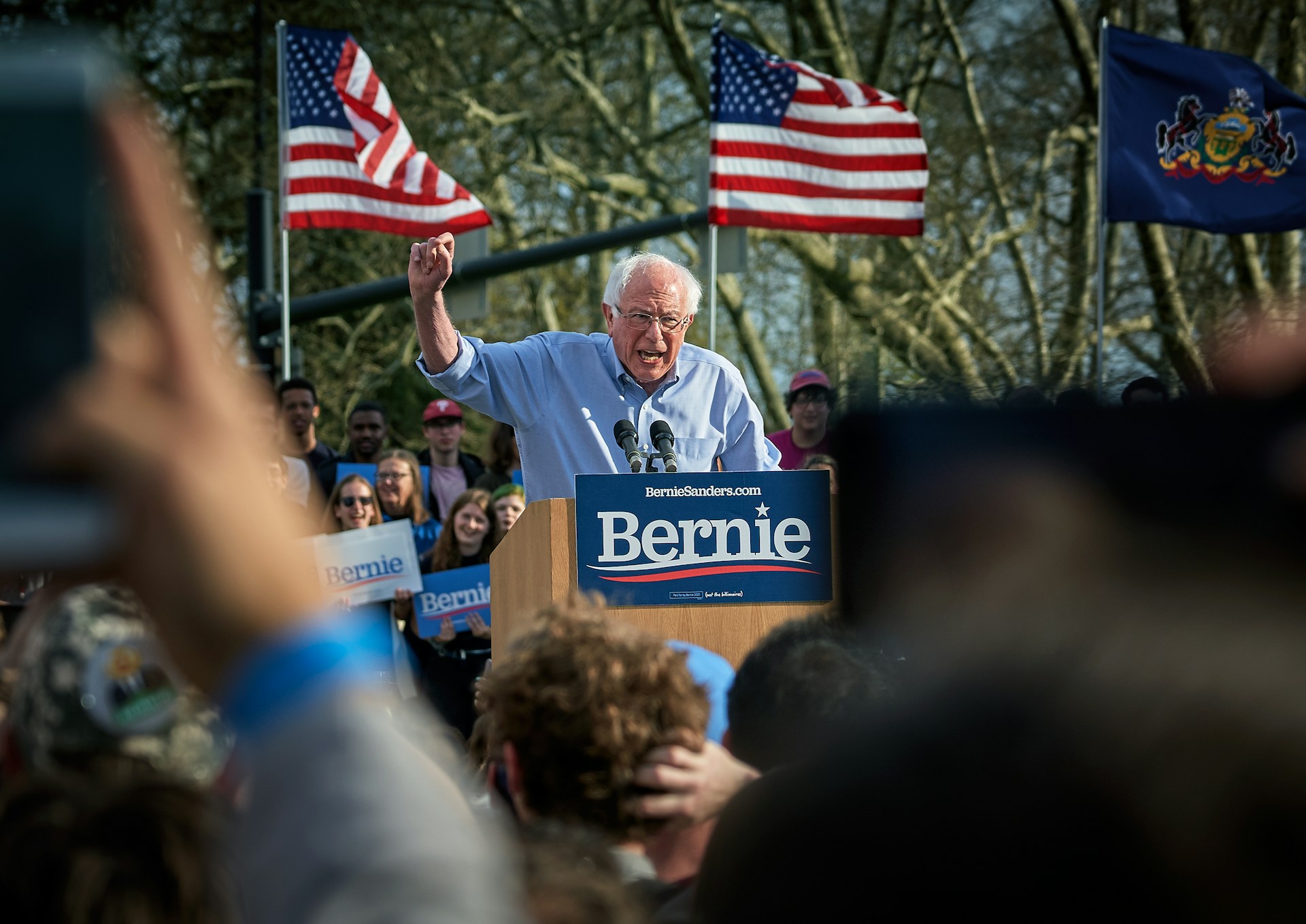This is a republishing of a post that I wrote in 2020. It still contains relevant lessons and important reflection, so I made the decision to post it to this new version of my website as well. Enjoy!
Oh, Bernie Sanders. To some, a rumpled and benevolent socialist uncle. To others, a bumbling but harmless elder, out of touch with the times. To still others, a real danger to the status quo from which they benefit. But the Bernie Sanders campaign is employing a branding strategy, intentionally or not (I think it’s intentional), known as hostile branding.
Hostile branding is a strategy of aggressive differentiation, often targeting the personal identity of the target market. Part of the strategy is to explicitly exclude those not in the target market, engendering feelings of exclusivity, aspiration, and/or uniqueness in the target audience.
In this post I want to take a look at some of the elements of the hostile brand, and see how they relate to the Bernie Sanders campaign in both 2016 and 2020.
Love it or Leave it
Part of hostile brand strategy is to choose a brand personality and stick to it, proudly and unapologetically. Bernie appeals on camera looking rumpled and disheveled, consistently and without apology or self-consciousness. He makes the same appeals over and over again, without adjusting to feedback that he recieves from the electorate. There are no apologies, sincere or not; no backtracking. He maintains the identity of “democratic socialist” despite the fact that it is alienating and frightening to some.
This forces people to either get in line behind Sanders or not. This is a part of why Sanders is a polarizing political figure.
Cult-like Appeal
The Love-it-or-leave-it strategy results in a kind of us-and-them mentality among Sanders’s most fervent supporters. You’re either with Bernie, or you’re an obstruction at best, an outright enemy at worst. I had a friend tell me during the 2016 campaign that if you didn’t support Bernie Sanders, “you’re basically Ann Coulter.”
Yeah, we’re not friends anymore.
This cult-like appeal is not an accident; it’s a strategy employed by the campaign. Sanders made himself into the leader of a movement (hence his political group, named Our Revolution), and that movement has revolutionary change at its heart. If you’re not embracing that revolutionary change, you’re one of Them.
This appeals to people of a certain identity; it reinforces that sense of identity and in fact rewards them for it with a sense of moral superiority.
Less is More
Sanders’s campaign is built on dreams. Aspirations. A vision of what America could be. There’s no real roadmap to those ends; he doesn’t talk about what he’ll do to implement these things with an actively oppositional Senate (and House, maybe. Who knows what the future holds).
I’m betting this is also not by accident.
Bernie Sanders is campaigning against the system, against the status quo, against the Democratic Party itself! Having plans to actually implement his agenda would involve the admission that he’d have to dirty his hands by working with The Enemy. An admission that instead of breaking the system, he would have to work from within it in order to produce the results he and his supporters want to see so very badly.
Moreover, it would be a tacit admission of the fact that their revolutionary movement could fail. Bernie paints every moment of his vision as all but inevitable; his supporters see it as a righteous revolution. Admitting that it could fail invites the chill of reality into that vision, and cools the fires of the passion he’s worked so hard to inspire.
Perceived Authenticity
Bernie’s lack of polish, his unabashed connection to socialism, his gruff manner, all of it lies in stark contrast to his political contemporaries. He is, in fact, breaking the rules. And breaking the rules, appearing to be different than others in the competitive field, is courting both success and disaster. Sanders’s willingness to maintain this persona in the face of possible disaster is a marker of authenticity.
Other politicians’ apparent bending to these rules of political campaigning makes them feel inauthentic; it implies that they are willing to change themselves to play the game.
This contrast is a strong differentiator; Sanders, as far as his stans are concerned, is not just another politician. And his apparent authenticity leads his stans to believe that he’s someone they can trust. He won’t just sell them down the river like the last politician and the last one, back into the mists of history. Bernie, as far as they can tell, is the Real Deal.
The Risks of Hostile Branding
Much of hostile branding is based around the alienation of the outsider. Lululemon alienates women who are “not meant” to wear yoga pants (meaning women who don’t adhere to the white, thin, young vision held by western beauty standards). American Eagle (and several other “fast fashion” brands) differentiated themselves unapologetically by refusing to offer sizing above the “straight sizing” range, excluding a large group of people from their offerings.
Most hostile brands see that there’s room to prosper within their chosen target market. The risk of alienating all others is factored into the brand’s strategy.
However, this can go two different ways: the hostile brand becomes aspirational for those it excludes, or the alienated become actively hostile to the brand, taking action against it, up to and including direct action, like calling for boycotts.
Because of this, if you’re running a branding campaign that relies on capturing the imagination of a large part of the population, you could end up shooting yourself in the foot by using hostile branding.
I’m not saying this can never be successful in politics; Donald Trump successfully employed hostile branding in much the same way Sanders did. The reason he succeeded is that he employed it while targeting a portion of the population that holds outsized economic and political power in the United States; white people.
Sanders cannot win with democrats this way, so it makes his use of this campaign strategy more complicated.
Hostile Branding and Populism
Populism is defined as “a political approach that strives to appeal to ordinary people who feel that their concerns are disregarded by established elite groups.”
It’s easy to see how populism and hostile branding go hand in hand. You find your enemy, your status quo, your establishment, your elites, and you position yourself in opposition to them.
However, as mentioned above, you must find a target audience that is large enough to drive your brand to success. It is difficult to later incorporate those who have been alienated by your brand.
The problem is, many of the “establishment democrats” that Sanders explicitly positions himself against have done good things, and/or represent ideas that resonate with the electorate. I had someone tell me that Sanders supporting Stacey Abrams is a line in the sand because of her connections with the finance industry.
Stacey Abrams represents a lot of things. She’s the first black female major party gubernatorial nominee in the United States. She was the first black woman to give a response to the state of the union address. And since her loss to Brian Kemp in the Georgia gubernatorial race, she’s dedicated her time to addressing racial inequity in voting rights.
Sanders is not his supporters, and did not come out in opposition to Abrams because of her ties to the finance industry, but Abrams is an establishment democrat, a member of the party. There are other examples of beloved establishment figures, and Sanders treads a delicate line when positioning himself against “party elites.”
Hostile Branding and National Politics
Regardless of your political inclinations, it’s easy to see why the democratic party is necessarily a big tent. It’s a more diverse party than the Republican party, and different groups within the party have different legislative and policy priorities.
The question is, can Bernie’s target market carry him to victory in the general election while he alienates the rest of the party?
I’m not so sure. People assume that his message of economic socialism will resonate with people, but the culinary union in Nevada vocally opposed Sanders during the primary, because they feared his healthcare plan would put their dearly fought for health benefits at risk. Sanders did not do well with southern black voters, despite his change in strategy from 2016 (which appears to mostly be not complaining about “identity politics” anymore), but he may be losing support from white middle america as a result of easing his stance on immigration.
It’s a delicate balance. Donald Trump could use racism to unite the largely white republican party. Given the democrats’ relative diversity, how can Sanders unite the party that he’s campaigning against?
He won’t do it by pretending that those other concerns don’t exist, that’s for sure.


Leave a Reply